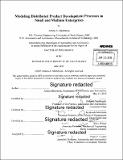| dc.contributor.advisor | Jayakanth Srinivasan. | en_US |
| dc.contributor.author | Mkrtchyan, Armen A | en_US |
| dc.contributor.other | Massachusetts Institute of Technology. Department of Aeronautics and Astronautics. | en_US |
| dc.date.accessioned | 2015-09-17T19:13:06Z | |
| dc.date.available | 2015-09-17T19:13:06Z | |
| dc.date.copyright | 2015 | en_US |
| dc.date.issued | 2015 | en_US |
| dc.identifier.uri | http://hdl.handle.net/1721.1/98801 | |
| dc.description | Thesis: Ph. D., Massachusetts Institute of Technology, Department of Aeronautics and Astronautics, 2015. | en_US |
| dc.description | Cataloged from PDF version of thesis. | en_US |
| dc.description | Includes bibliographical references (pages 193-207). | en_US |
| dc.description.abstract | Effective and efficient product development (PD) is critical to the success of many firms. The market's emphasis on getting faster and cheaper products has forced firms to shift their PD practices from sequential to distributed development practices. This shift has significantly increased complexity and dynamism of PD processes, but often is not sufficiently accounted for by PD managers. Transitioning to distributed PD processes is even more challenging for Small and Medium Enterprises (SMEs), who usually lack resources to secure external help. Furthermore, SMEs have been increasingly using distributed PD to not only cut costs but also accelerate PD processes, which adds extra complexity to the management of PD processes. The objective of this thesis is to develop a generalizable model of distributed PD to aid SMEs better manage their PD processes. First, I identified the necessary attributes that have to be captured in distributed PD process modeling within SMEs using firm interviews and academic literature. I validated the attribute list using firm surveys. Next, I developed a discrete-event simulation model that accounted for task structure, rework, multiple teams, flexible work hours, individual performance ratings and learning curve factors. The model is designed to calculate project completion time and cost. In addition, it generates a probability distribution function of completion time that can be used to further guide PD manager decision-making. I encapsulated the model within a software application called SimLinkTM for both Mac OS® and iOS@ mobile devices. Finally, I adopted a multistage validation process using both historical data sets and ongoing project data to accurately replicate observed results and guide decision making in real world scenario. I built additional confidence in model's predictive ability through sensitivity and stochasticity analysis. The application can be used to evaluate the impact of different PD attributes and analyze various PD scenarios before implementing them in real world. Specifically, the application (and underlying model) has been used to investigate cost and schedule targets for various PD staffing configurations, as well as to analyze the impact of around-the-clock development activities. Lastly, model limitations and generalizability to other PD settings are discussed. | en_US |
| dc.description.statementofresponsibility | by Armen A. Mkrtchyan. | en_US |
| dc.format.extent | 207 pages | en_US |
| dc.language.iso | eng | en_US |
| dc.publisher | Massachusetts Institute of Technology | en_US |
| dc.rights | M.I.T. theses are protected by copyright. They may be viewed from this source for any purpose, but reproduction or distribution in any format is prohibited without written permission. See provided URL for inquiries about permission. | en_US |
| dc.rights.uri | http://dspace.mit.edu/handle/1721.1/7582 | en_US |
| dc.subject | Aeronautics and Astronautics. | en_US |
| dc.title | Modeling distributed product development processes in small and medium enterprises | en_US |
| dc.title.alternative | Modeling distributed product development processes in SMEs | en_US |
| dc.type | Thesis | en_US |
| dc.description.degree | Ph. D. | en_US |
| dc.contributor.department | Massachusetts Institute of Technology. Department of Aeronautics and Astronautics | |
| dc.identifier.oclc | 921146445 | en_US |
